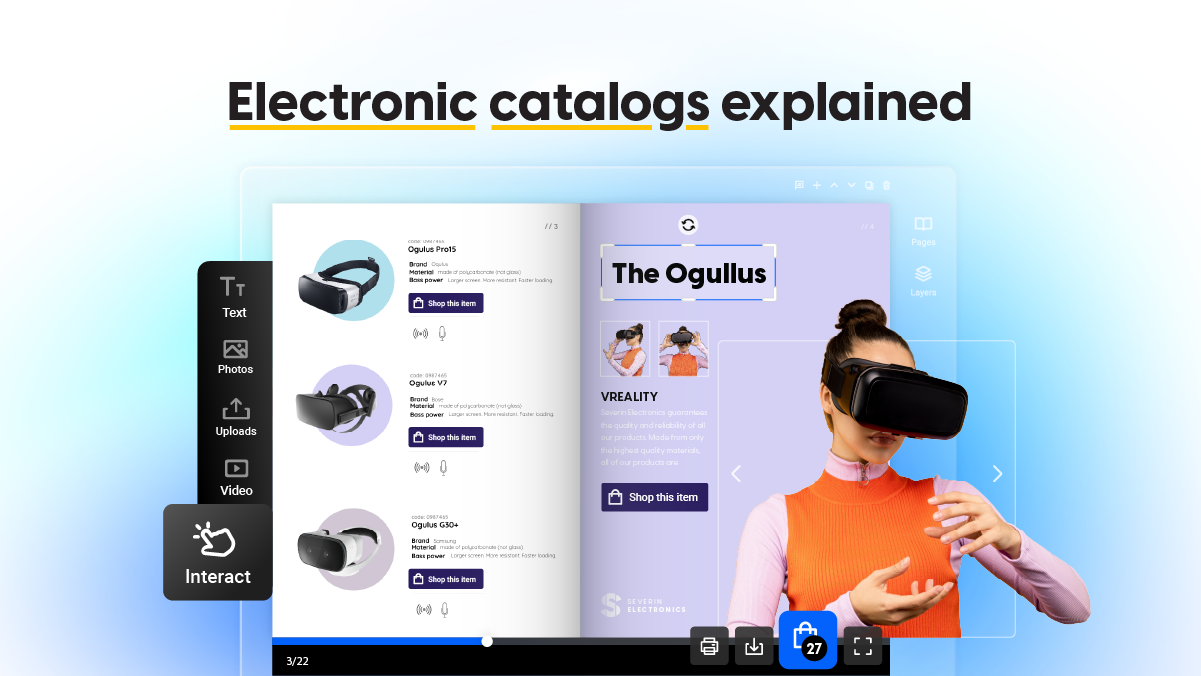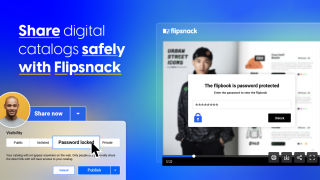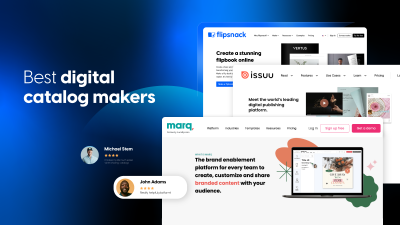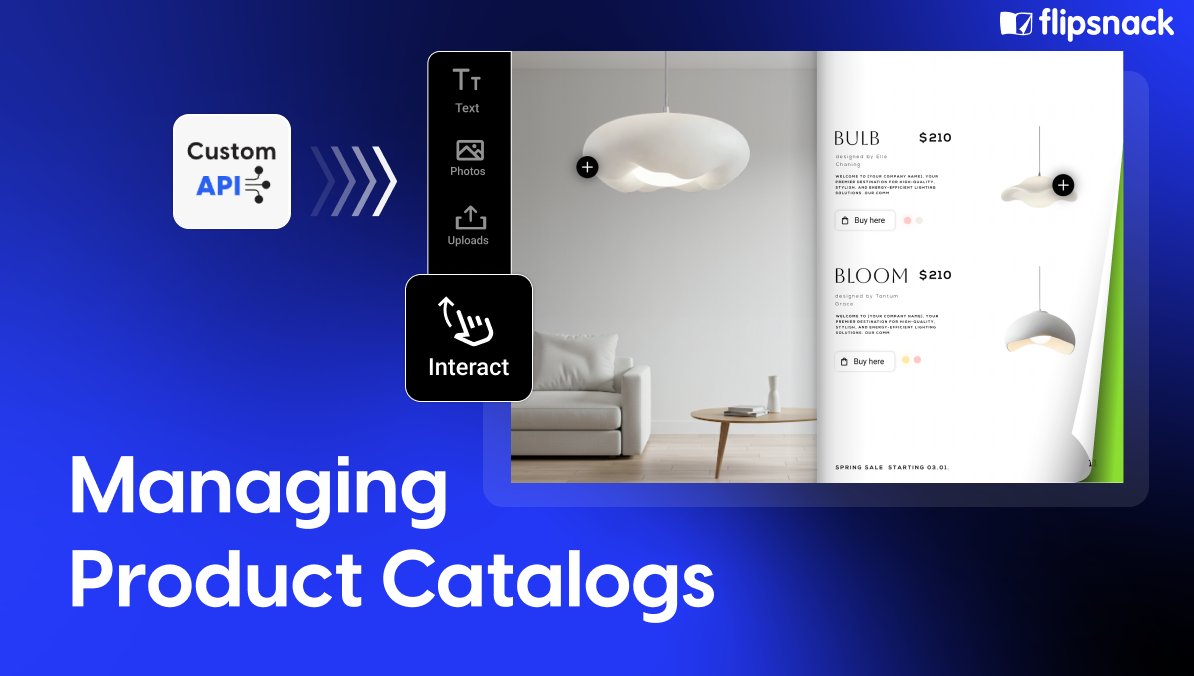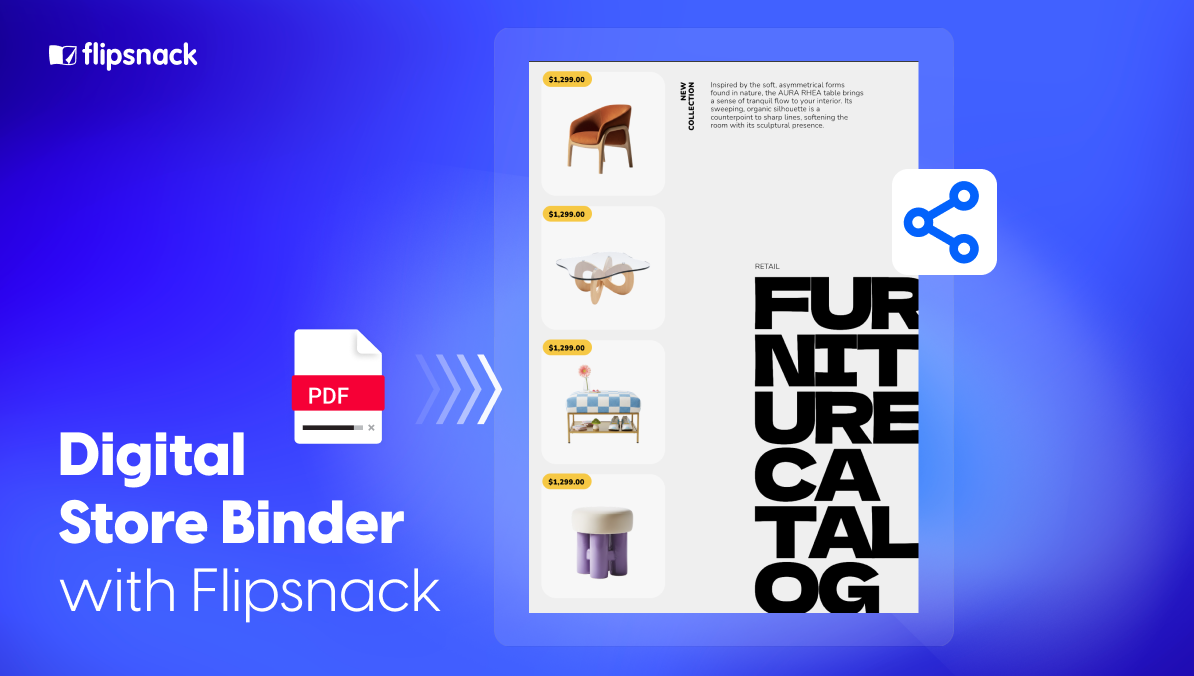E-catalogs. Your guide to creating electronic catalogs
Last updated: October 17th, 2025
If you work in retail, wholesale, or distribution, you know how painful catalog management can be. Product details or pricing change quickly, and by the time your catalog is ready for the public eye, another update has already occurred. That means another outdated PDF and thousands of printed catalogs that are instantly obsolete. These problems are not only costly but also frustrating for both sales reps and customers.
That’s why more companies are turning to digital catalogs: dynamic, interactive tools that do far more than display products. With the right e-catalog software, teams can automate updates, reduce human error, and give buyers an engaging browsing and ordering experience.
At Flipsnack, we built our platform to solve these exact challenges. It lets you create immersive product experiences, update content in real time, share instantly, and analyze how customers engage, all without starting from scratch each time.
In this article, you’ll learn how to create an effective e-catalog that adapts to your workflow, enhances buyer engagement, and drives measurable growth for your business.
Table of contents
- Why choose Flipsnack as your e-catalog solution?
- The basic elements of a standard e-catalog
- How to create an e-catalog in Flipsnack
- Benefits of implementing e-catalogs for enterprises
- 1. Simplified catalog creation with automation
- 2. Easier way to share and reach your audience
- 3. Improved product discovery through interactive and accessible e-catalogs
- 4. Enforced brand identity across every digital catalog
- 5. Product information accurate with real-time catalog updates
- 6. Increased sales via e-catalog orders
- 7. Access to in-depth catalog statistics
- 8. Reduced production and distribution costs
- How Electrolux scaled catalog reach with Flipsnack
- Design best practices for engaging e-catalogs
- Frequently asked questions about electronic catalogues
- Embrace the power of e-catalogs in your retail & wholesale business
First, let’s start with the basics.
An electronic catalog, often called an e-catalog or digital catalog, is an online publication that displays products or services in an organized, searchable format. It can include multimedia elements like images, videos, or links, allowing buyers to explore products and make decisions faster.
Unlike a static PDF, a modern e-catalog lets you update prices, descriptions, and visuals instantly. That means no more reprinting or resending outdated files. For businesses that manage hundreds of SKUs or frequently changing product lines, this level of flexibility is essential.
Companies use electronic catalogs to simplify product discovery, boost engagement, and improve online conversions. With integrations into e-commerce platforms or CRMs, e-catalogs make it easier for marketing and sales teams to manage content, track results, and keep information consistent across every channel. In short, they’re the foundation of a smarter catalog system for B2B sales.
Why choose Flipsnack as your e-catalog solution?
Choosing the right b2b e-catalog software goes beyond simply turning a PDF into a flippable document. It’s about selecting a tool that supports your workflow, helps your team collaborate, and turns product content into real sales results.
With Flipsnack, you can:
- Add interactive elements like videos, links, and shopping lists to create engaging buying experiences.
- Customize layouts and branding to ensure every catalog reflects your company’s identity.
- Track performance and customer engagement to see how readers interact with your products.
- Automate updates and content population to save time and minimize manual errors.
- Integrate with tools like Shopify, Zapier, and Slack for faster, more connected workflows.
- Protect your data with enterprise-grade security
Flipsnack helps retail, wholesale, and marketing teams build electronic catalogs that are not only visually engaging but also accurate and measurable.
The basic elements of a standard e-catalog
- Product name
- Product photo
- Short description
- Specifications, sizes, delivery info, discounts, technical info
- Benefits of the product
- Price
- Buy buttons/ links for easy shopping (or shop addresses if the products are sold through retailers)
Product name
In both regular and e-catalogs, the product name is crucial as it serves as the primary identifier for each item. It should be clear, concise, and descriptive to help customers easily recognize and understand the product. A catchy and informative product name can grab customers’ attention and interest, encouraging them to learn more about the item.
Product photo
The product photo has the purpose of visually representing the product. Similar to the product name, it should captivate the shopper’s attention and create an interest to explore the product more. The photos should be of high quality, so make sure you invest in the best camera for product photography. But most importantly, the photos should accurately represent the product. Through Flipsnack, you could even include a photo slideshow displaying the product from multiple angles, offering as much information as possible.
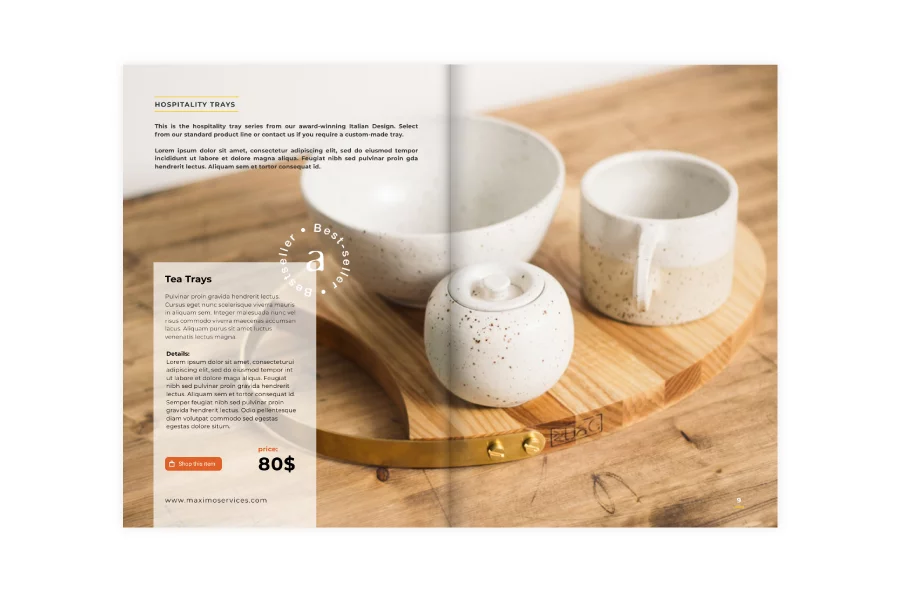
Short description
A short description gives a quick overview of the product’s key features and advantages. It should highlight what makes the item unique and why it matters to the customer. Use tools like Axios HQ text summarizer to create concise, effective summaries that capture attention. For added accessibility, consider adding a professional voice-over to make the description more engaging for all audiences.
Product information
Include essential product details such as specifications, dimensions, delivery options, discounts, and technical information, anything that helps customers make informed decisions. The more transparent this section is, the more confident buyers will feel about your offer.
For complex products, consider adding instructional videos or step-by-step guides to simplify the learning process. You can even record a quick tutorial or troubleshooting guide using a screen recorder to make the information more accessible and engaging.
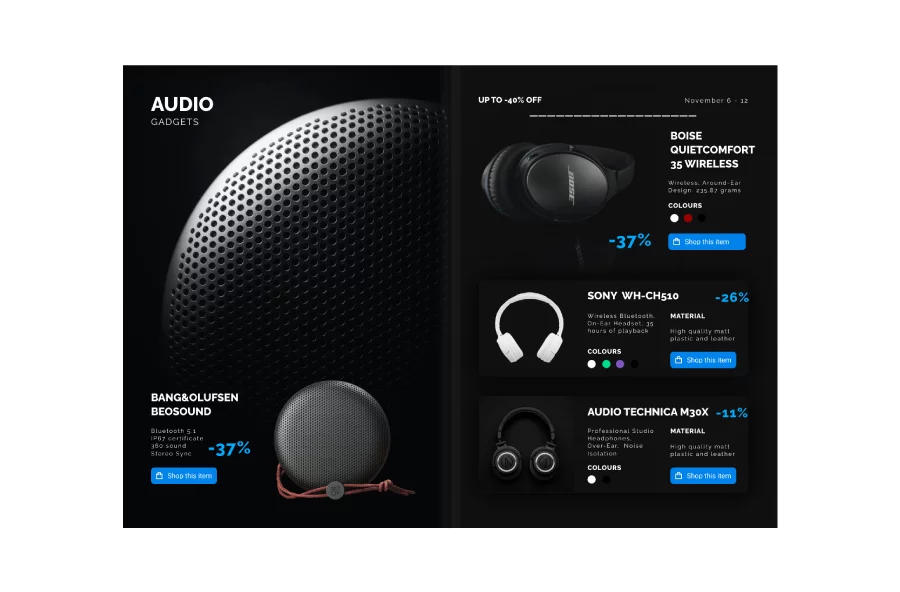
Product benefits
It’s important to emphasize the product’s advantages to convince customers of its significance and relevance to their needs. While the previous part focused on specifics and technicalities, this part should present how the product solves a pain point, fulfills a desire, or enhances the customer’s life. By clearly defining the benefits, you help your customers envision how the product suits their needs, which could encourage them to consider buying the product.
Price
The price is one of the most important pieces of information to display in an e-catalog. It allows your customers to quickly determine the value and affordability of the product. Like the image, the pricing information should be presented plainly and transparently.
If there are any variations based on sizes, materials, or colors, display them. If there are discounts, display them. As mentioned, prices can often change, so updating your catalog with the latest price information is important.
A customer might browse multiple catalogs at once, and it could be helpful for customers to see the prices displayed. This allows them to make informed decisions and compare prices if needed.
Buy buttons
By adding buy buttons in your e-catalog, you simplify the shopping process for your customers. Whether we are talking about connecting your catalog with an online shop such as Shopify or including a shopping list that customers can use to email you their orders, buy buttons are beneficial.
Instead of having to browse through your catalog, then to your website, and on and on and on, a buy button allows customers to place orders directly from the catalog. Cutting a few steps from the purchasing process could increase your sales.
How to create an e-catalog in Flipsnack
You’ve seen what goes into an effective e-catalog, from its key elements to the details that make each product stand out. Now it’s time to put it all together. Here’s how you can create your own professional e-catalog in just a few simple steps with Flipsnack.
Upload your PDF, start from scratch or use a template
Flipsnack is known as the fastest PDF-to-flipbook converter on the market, so simply upload your existing PDF to Flipsnack and convert it into a digital catalog in seconds. Additionally, you can start the process from scratch in our Design Studio or choose a professional catalog template.
Add images, descriptions, and product information
Once your PDF is uploaded, add high-quality images and product details such as name, description, price, size, materials, etc. To finish this process faster, use our product catalog generator or automation feature and save time. Simply connect your data source (CSV, XSLX, or Google Spreadsheet) and connect it to Flipsnack.
Customize and brand your e-catalog
Enhance your electronic catalogues with interactive elements such as videos, photo slideshows, product tags, and even include the shopping list feature to allow customers to send orders directly from the catalog. Don’t forget to make the e-catalog on-brand by adding your company’s branding elements like logo, color palette, and font style.
Share your electronic catalog instantly
If you want to expand your electronic catalog’s reach, enable Flipsnack’s AI accessibility solution and enable screen readers to easily identify the content within your catalog. Readers will then be able to navigate through each element using their keyboard and successfully understand what products you’re selling.
After you publish the digital catalog, share it publicly via email, link, QR code, or even embed it on your website to provide instant customer access and maximize conversions. Hence, using tools like Nostra AI (read Nostra AI review here) can help you achieve that effortlessly. However, if you first need to share it privately with stakeholders or managers to get their approval on some aspects, send it via a password-protected link or share it via email but only with specific email addresses.
Measure your catalog’s performance
Once your catalog is live, use Flipsnack’s analytics dashboard to track engagement and identify what resonates most with your audience. You’ll see how customers interact with your content, which helps you refine future editions and continuously improve results.
Benefits of implementing e-catalogs for enterprises
Before we get into the specifics and best practices when creating an e-catalog, let’s see why you should use them in the first place.
These are the main benefits of using e-catalogs for your business:
- Simplified catalog creation with automation
- Easier way to share and reach your audience
- Improved product discovery through interactive and accessible e-catalogs
- Enforced brand identity across every digital catalog
- Product information accurate with real-time catalog updates
- Increased sales via e-catalog orders
- Access to in-depth catalog statistics
- Reduced production and distribution costs
Let’s take a look at each of them one by one:
1. Simplified catalog creation with automation
Flipsnack makes it simple to create professional, up-to-date product catalogs. Our automation tools adapt to your workflow, offering several ways to build electronic catalogs quickly and efficiently.
For retailers and wholesalers who produce catalogs frequently, the product catalog generator is the fastest option. You can import your product data and, within minutes, Flipsnack automatically generates a complete catalog. Perfect when you need professional results and have no time to spare.
If you want more creative control, try drag-and-drop automation. Connect your product data from a Google Spreadsheet, CSV, Excel file, or through an API connection, link it to your catalog design, and simply drag elements into place. Flipsnack instantly populates each page while keeping layouts consistent and accurate. You can also save your design as a template to reuse later, ensuring branding and layout stay consistent across every edition.
Already have a catalog design in PDF format? Upload it and transform it into a shoppable e-catalog with Flipsnack’s SKU detection feature, which automatically links product codes to interactive areas displaying product details.

2. Easier way to share and reach your audience
One of the biggest advantages of electronic catalogs is how easy they are to share and access. Unlike printed materials, e-catalogs let customers browse your products anytime, anywhere, and on any device. They automatically adjust to any screen size, ensuring a smooth, responsive viewing experience on phones, tablets, and desktops.
With Flipsnack, sharing your catalog takes just a few clicks. You can distribute it publicly by posting it on social media, embedding it on your website, sharing it through a direct link, or even generating a QR code so customers can scan and open it instantly.
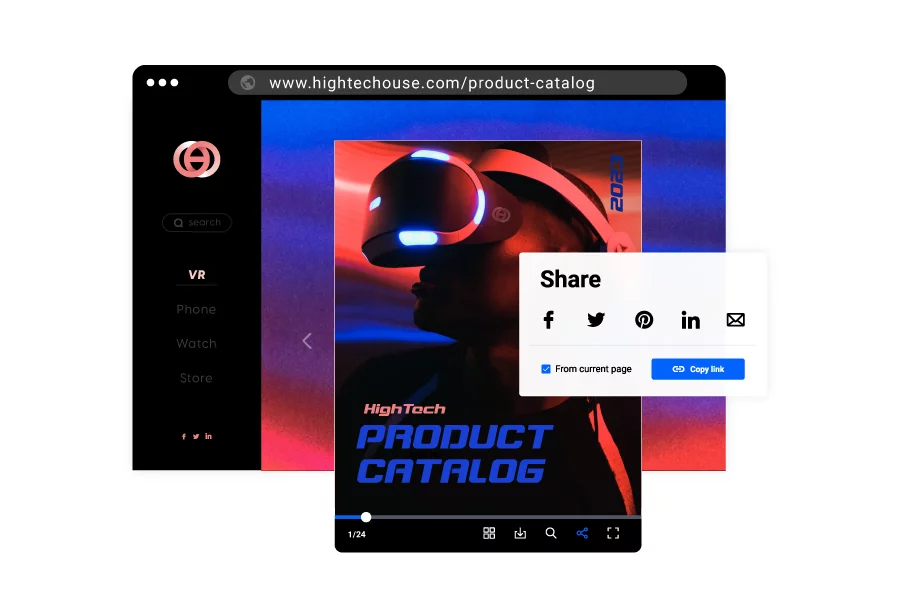
For situations where catalogs are meant for specific partners or retailers, Flipsnack also offers private sharing options. You can share catalogs via email with selected recipients, protect access with a password or a one-time passcode, and control who can view or download your content.
3. Improved product discovery through interactive and accessible e-catalogs
An electronic catalog makes it easier for customers to discover and explore your products. Unlike a website, where visitors can easily get lost, or a printed catalog, which limits engagement, a digital catalog helps guide buyers’ attention to featured products and key offers.
Beyond placing products strategically on each page, e-catalogs let you include interactive elements that drive engagement and make exploration effortless. You can embed videos that showcase your products in use, or even integrate 3D models directly into your catalog, allowing readers to view items from every angle.
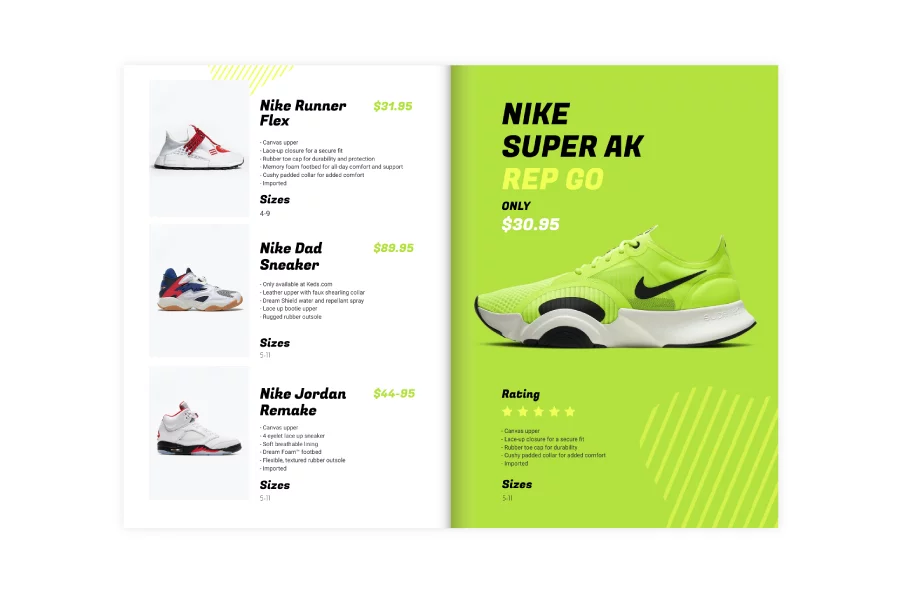
Improved product discovery also means improved accessibility. With Flipsnack, catalogs meet WCAG and ADA standards, offering full keyboard and screen reader navigation.
Every interactive element includes clear labels for screen readers, while creators can set custom titles and descriptions for each page. You can even generate AI page summaries to make your catalog content easier to understand and accessible to everyone.
4. Enforced brand identity across every digital catalog
A strong brand presence doesn’t stop at your website. It should extend to every touchpoint, including your electronic catalogs.
With Flipsnack’s branding capabilities, businesses can create fully on-brand digital catalogs that reinforce their identity at every level. From custom logos, brand colors, and typography to URL personalization and white-labeling, every catalog remains a seamless extension of your company’s image.
For enterprises requiring a branded digital experience, Flipsnack ensures that catalogs don’t just look professional, they feel like an integrated part of your marketing ecosystem. Flipsnack provides the customization and control needed to maintain a consistent, polished brand experience across all channels.
5. Product information accurate with real-time catalog updates
Traditional catalogs might become outdated as soon as they reach their audience. Prices could change, products might no longer be available, or the catalog might contain unnoticed errors. In this case, you either make the changes, which takes time and money, or you leave the catalog as it is.
Updating an electronic catalog is much easier. All you have to do is make the changes in your spreadsheet or within the catalog, and your audience will automatically see the latest version under the same link. This means you can update your catalog with new discount codes or coupons, products or promotions, without having to resend an updated version and hope everyone reads it.
6. Increased sales via e-catalog orders
Switching to electronic catalogs isn’t just about going digital, it’s about improving how you sell. Digital catalogs make ordering easier through interactive product pages, clickable shopping buttons, and intuitive order forms that remove friction from the buying process.
With Flipsnack’s interactive features, you can turn browsing into buying. Using shop buttons, you can display all essential product details in a popup—such as descriptions, sizes, colors, or other variations—so customers can preview options and place orders in just a few clicks, leading to faster decisions and higher purchase rates.
The shopping list feature makes ordering even more convenient. Customers can add products directly to their in-catalog list and send orders straight to your team, triggering an instant notification via email or WhatsApp.
Whether you embed your catalog on a website, share it in email campaigns, or integrate it with an e-commerce platform, Flipsnack ensures every digital catalog acts as a powerful sales engine, helping you improve B2B sales with digital catalogs and drive measurable revenue growth.
7. Access to in-depth catalog statistics
Flipsnack’s electronic catalogs come with built-in analytics tools that give you a complete view of how your catalogs perform. You can track key metrics such as page views, time spent per page, and interactions, or use heatmaps to see which sections of your catalog generate the most interest. These insights reveal how customers engage with your content and which products attract the most attention.
But analytics in Flipsnack go beyond reader behavior. You can also gain visibility into purchases made directly through your catalog. You can view total revenue, number of orders, and even see which products drive the highest sales and conversions. This makes measuring ROI of digital sales enablement tools faster, easier, and far more accurate.
To simplify decision-making, Flipsnack also includes AI-powered insights. With a single click, you can generate automated reports summarizing your catalog’s performance, engagement trends, and actionable recommendations to help you refine your next edition.
8. Reduced production and distribution costs
An e catalog can help your business save money because the costs associated with publishing are greatly reduced. No money is spent on printing, shipping, or updating your catalog, and no time is wasted ensuring the catalog is 100% mistake-free (which is almost impossible).
This allows businesses to allocate their budgets and efforts to other priorities. Using electronic catalogs only involves designing the catalog, sharing it, and updating it when necessary.
And given that companies spend a lot of money on printing, going paperless is a great solution.
How Electrolux scaled catalog reach with Flipsnack
Electrolux Group wanted to modernize how they create and distribute product catalogs across Europe, especially for trade partners and retailers. They needed a digital tool that could evolve with their needs, deliver interactive experiences, and simplify updates.
Here’s how they used Flipsnack, and what they achieved:
- Electrolux rolled out Flipsnack across 17 countries, publishing over 345 flipbooks.
- Their catalogs produced 104,400 impressions, 76,300 product catalog views, and 8,800 downloads.
- They added interactive elements making content richer without clutter. To scale, they used automation to speed catalog creation.
- Their flipbooks remained visually polished on all devices, and catalog updates could be pushed instantly.
Electrolux’s journey shows that switching from static to electronic catalogs isn’t just digital, it’s transformational. By embracing interactive content, automation, and performance tracking, they turned catalogs into assets that engage partners, simplify distribution, and drive measurable reach.
Design best practices for engaging e-catalogs
With the basic elements of an electronic catalog out of the way, let’s look at some e-catalog design best practices.
Tailor the e-catalog according to your brand
When designing your e-catalog, always keep your audience in mind—but never compromise on brand identity. Your catalog should reflect who you are as a business and create a consistent visual story across every page.
Include your brand colors, fonts, logo, and typography so your catalog feels like a natural part of your brand ecosystem. Repeating these elements throughout reinforces recognition and builds trust. A cohesive style not only looks professional but also makes browsing more enjoyable and familiar for your audience.
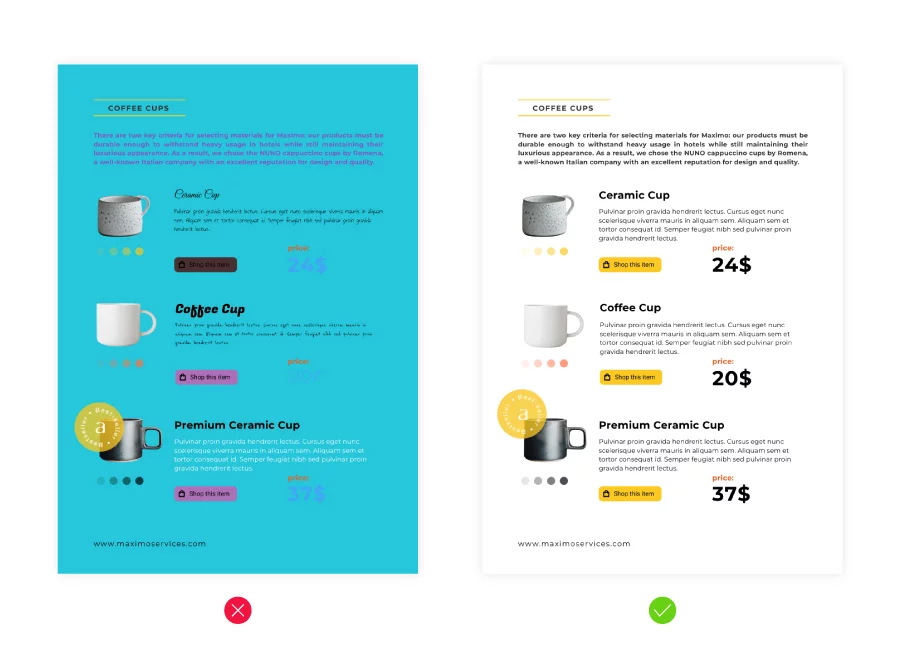
Avoid clutter in your electronic catalogs
Too much information can overwhelm your readers and make it difficult to focus on a single product. It’s tempting to think that showing more products means more sales, but a cluttered layout often has the opposite effect.
Use plenty of white space and keep your layout clean and organized. Highlight your key products with a clear visual hierarchy and avoid filling every inch of the page. A simple, well-structured catalog is easier to read, more visually appealing, and helps customers focus on what matters most.
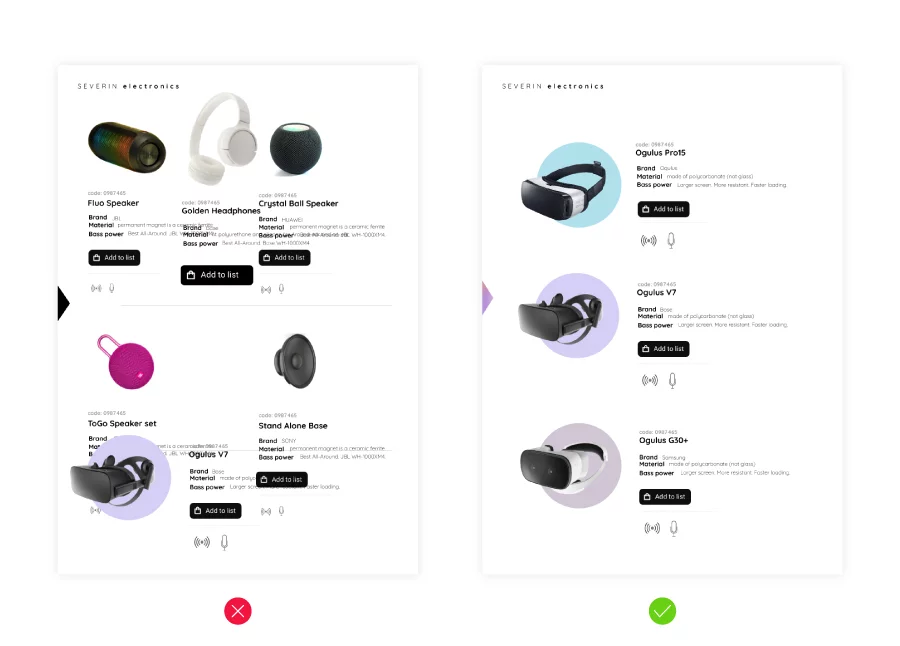
Use professional & high-quality images
High-quality images are essential for any successful e-catalog. They’re the first thing readers notice, and they shape their perception of your products. Make sure each image is sharp, well-lit, and true to life.
Accurate visuals help customers trust what they see and reduce the risk of disappointment when they order. Investing in good photography, or using high-resolution product renders, can make all the difference between a catalog that converts and one that doesn’t.
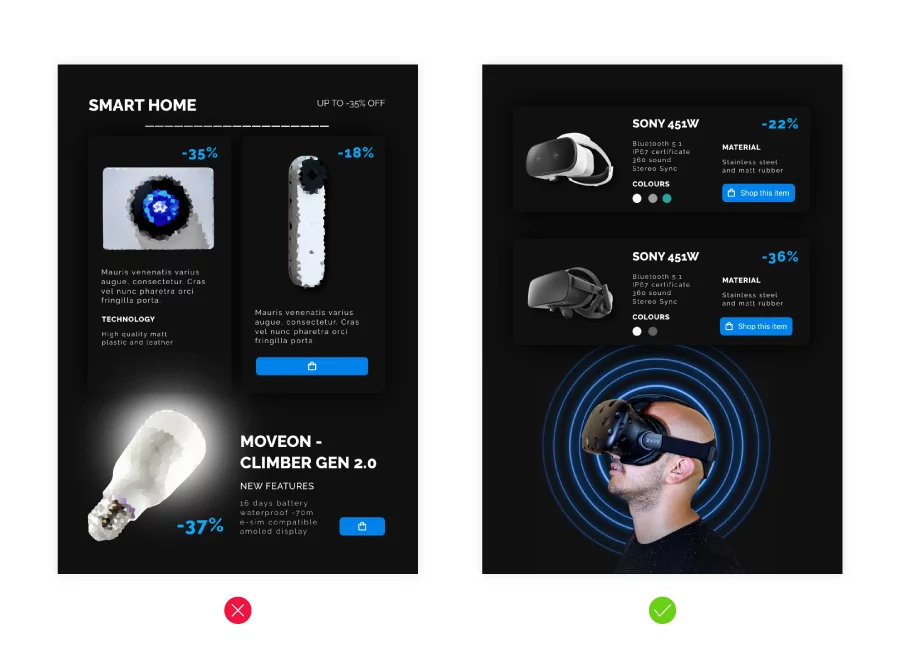
Avoid busy backgrounds in electronic catalogues
Just like clutter, busy backgrounds can distract from your products. Keep the focus on what you’re selling, not what’s behind it. Simple, neutral backgrounds make your items stand out and help maintain a clean, professional look.
Choose background colors that complement your products instead of competing with them. The goal is balance. Your design should guide the eye naturally to the product itself.
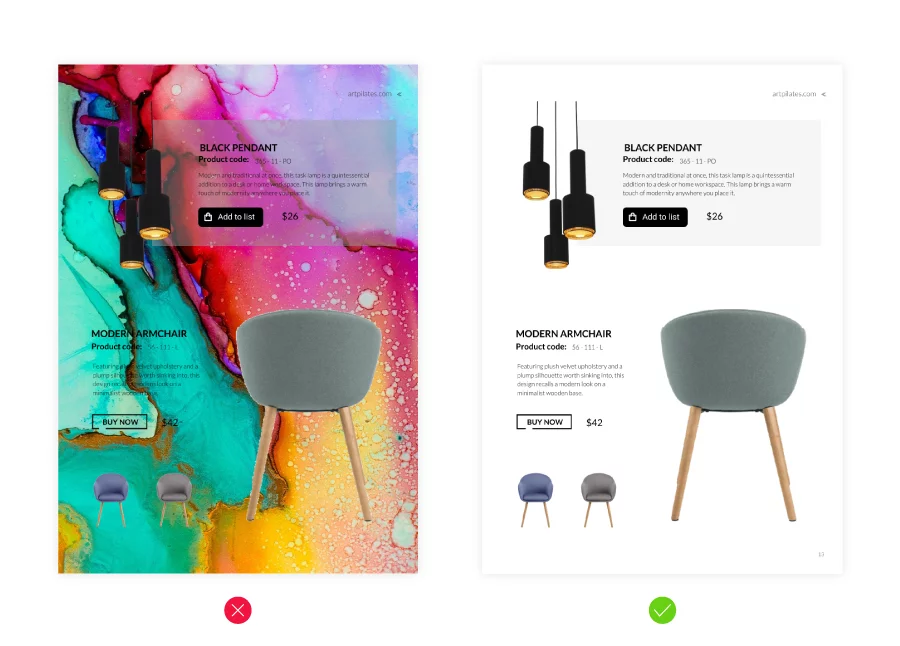
Place the content properly
Text placement has a major impact on how customers interact with your catalog. For best results, position product descriptions either below or to the left of images. This layout makes it easy for readers to connect visuals with information, improving both comprehension and flow.
Typography also plays a key role. Use consistent fonts, appropriate sizes, and balanced line spacing to keep your content legible and pleasant to read. A catalog with well-placed, easy-to-read text feels more polished and professional.
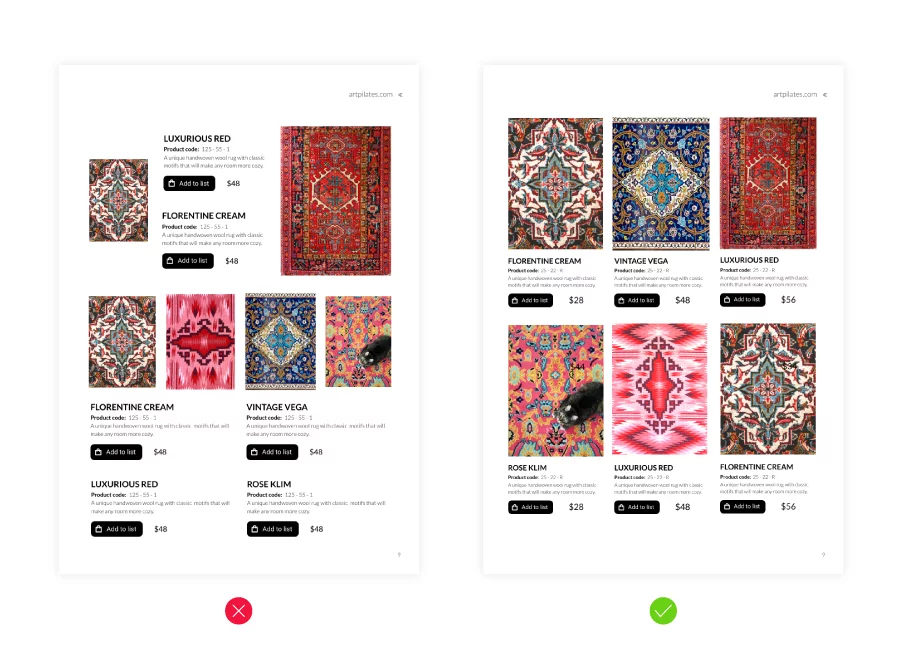
By following these e-catalog design principles, you’ll create a clean, user-friendly catalog that highlights your products effectively, boosts engagement, and helps increase conversions.
Frequently asked questions about electronic catalogues
Use data analytics to understand customer preferences and behaviors, then tailor product recommendations and offers for each group. Segmenting your audience allows you to deliver relevant content that feels personal and drives higher engagement.
Advanced features include AR product views, videos, interactive elements like quizzes, and chatbots for instant customer service. These additions make e-catalogs more engaging and keep readers exploring longer.
Promote your e-catalogs through social media, email campaigns, and SEO. Use targeted ads to reach your audience and collaborate with partners or influencers to extend visibility and attract more viewers.
Yes, but now they order from digital catalogs. Modern e-catalogs allow customers to browse, compare, and purchase products online with interactive features like videos, clickable links, and shopping lists. Businesses use digital catalogs to enhance customer experience, and drive e-commerce sales, making them a vital tool in today’s online shopping landscape.
The three common types of online catalogs are:
Product catalogs – Digital catalogs used by businesses to showcase and sell products online, often featuring images, descriptions, prices, and direct purchase links.
Interactive catalogs – Engaging catalogs with multimedia elements like videos, animations, and clickable links to enhance customer experience and drive conversions.
B2B catalogs – Specialized catalogs designed for business-to-business transactions, offering bulk pricing, custom quotes, and integration with procurement systems.
Digital catalogs shorten the sales cycle by providing customers with a well-structured product catalog that includes accurate, high-quality product information, all in one place. With automation, businesses can create and update catalogs fast, reducing time to market and ensuring customers always see the latest version.
A well-structured digital catalog gives clients a fast, reliable way to find and evaluate products. By offering a single, always up-to-date source of information, you simplify procurement, reduce quoting errors, and make purchasing easier for partners.
Embrace the power of e-catalogs in your retail & wholesale business
Electronic catalogs have become essential for businesses looking to increase sales and improve customer engagement with ease. As we’ve discussed, handling complex catalog management solutions is no longer an option.
Flipsnack is the right digital catalogue maker for retailers, wholesalers, and marketers to easily create electronic catalogs with real-time updates, catalog automation capabilities, and simplified tracking.
We’ve already covered the many advantages Flipsnack’s digital catalogs offer and how they can become your next powerful sales enablement tool. So, now that you know what makes an effective e-catalog and the best practices for creating one, why not take the next step? Upload a PDF and start designing your digital catalog today!
